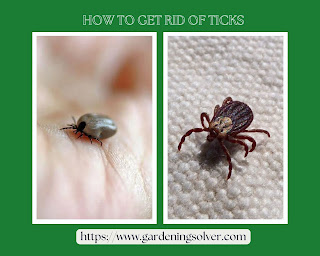How to Get Rid of Ticks: A Comprehensive Guide
Sadly, they often attach themselves to humans and animals to get that blood they need. What's even more concerning is that some certain types of ticks can carry harmful diseases such as Lyme Disease. Therefore when it comes to ticks you must always be armed with the right information for dealing with them.
In this guide, we'll look at the most effective methods for getting rid of ticks in your home and yard. We'll also walk you through more detailed information about protecting yourself, your family, and your pets from these critters.
Disclosure: This post contains affiliate links. We may receive commissions on purchases made from our chosen links with no extra cost to you. Learn more.
Section 1: Getting Rid of Ticks in the Home & Yard
Getting rid of ticks in your yard and home is an important first step in protecting your pets and family. Here are some steps you can take to help prevent ticks from infesting your home and yard.
Thorough House Cleaning
Vacuum and clean your home regularly so that any ticks that have made their way into your home are removed. Make sure no stone is left unturned so that you do not only remove ticks, but also eggs that may be hiding in your house. Additionally, seal up cracks in your home because that's where ticks usually hide.
Yard Clean-up
You can also reduce areas where ticks can thrive by keeping your lawn mowed, clearing debris, removing any overgrown vegetation, and other conditions that can attract pests that might carry ticks.
Use Tick Repellent
Consider using tick repellent products as they're also an important part of tick prevention strategies. Here are three best tick repellents sprays and one best tick repellent tube:
Important Notice: These products are not formulated for direct application on pets, they're only meant for use on surfaces.
Vet's Best Flea and Tick Yard and Kennel Spray
The Vet's Best is a natural spray that can be used anywhere that you want to protect from ticks, like in kennels, patios, lawns, and other outdoor areas. It kills all the different life stages of ticks and fleas. It comes with a ready to use hose attachment that allows you to easily apply the solution.
Wondercide - Ready to Use Flea, Tick, Yard Spray
Wondercide spray is the best for repelling fleas, mosquitoes, ticks and other pests. It is made with natural ingredients which are safe for pets and humans. The added benefit of this product is that it is safe for both indoors and outdoors use.
TropiClean Natural Flea and Tick Yard Spray
TropiClean is also a great option for killing fleas and ticks at all stages of development. Just like Wondercide spray, this spray also contains natural ingredients. However, it can only be used outdoors.
Thermacell Tick Control Tubes for Yards
These little tubes are quite different from sprays. They provide a dual-action approach to get rid of ticks. They contain a chemical attractant that draws ticks in, and permethrin, which kills the ticks when they come into contact with it. You simply place them around your yard and let them do the work.
Section 2: Protect Yourself & Your Family
To avoid tick bites, especially when spending time in wooded areas where ticks are more common, you should wear long sleeves and long pants. Try to tuck pants into socks and shirts into pants to further protect your skin. If possible, you can wear the muck boots and tuck pants inside.
Another effective way to prevent ticks from biting you is to use insect repellent. Make sure to choose a repellent that doesn't contain harsh ingredients. Try safe products like Murphey's Naturals Lemon Eucalyptus.
NB: After spending time outdoors, check your body for ticks. Focus on hidden areas like armpits, and behind your ears.
How to Safely Remove Tick
Even though removing a tick is an unpleasant process, it's important to remove it as soon as you find it on your body. Make sure to use fine-tipped tweezers or tick removal tools. Experts strongly discourage removing a tick with your fingers as it may do more harm than good.
After removing a tick, wash the area with soap and water. Then, apply an over-the-counter antiseptic ointment or cream such as Neosporin antibiotic ointment. It prevents infection and soothes the skin. However, if you develop any symptoms after a tick bite, like fever, rash, and body aches, seek medical attention right away.
Section 3: Essential Tips for Pet Owners
For pet owners, keeping your furry friends safe from these blood suckers is very important. Here are some measures to prevent ticks and how to get rid of any that are already in your pets.
(i) Ticks Removal in Pets
Remove ticks that you find on your pets as soon as possible. This is very crucial to reduce the risk of transmission of disease and minimize further irritation to your pet. Do not twist or crush the ticks. Use a tick removal tool that is specifically designed to remove ticks safely.
After the tick has been removed, you can wash the area with soap and water. Additionally, you can apply an antibiotic ointment in order to prevent infection. But if your pet shows any severe symptoms, it is recommended to seek a medical professional for further treatment.
(ii) Prevention Measures
Keep your pets away from areas where ticks are known to be common particularly in moist and humid areas. However, if there's a need to take your pet into such areas, it is essential to thoroughly check your pets afterwards.
Other best methods to prevent ticks from infesting your pets is by using sprays, tick collars, meds, shampoos, etc . Most pet sprays are designed to be applied directly to a pet's coat in order to create a barrier that kills and repels ticks. So you can simply apply it before taking your pet outdoors
Then ticks collars are designed to kill ticks that come into contact with the animal, whereas oral meds and shampoos deter these little pests from approaching the animal in the first place. All these are effective at preventing and controlling ticks, but it's important to use them as directed to ensure their effectiveness.
You Might Also Like
How to Get Rid of Mosquitoes in Your Home
How to Control Japanese Beetles and Grubs







Comments
Post a Comment
Have something to say? Feel free to leave a comment.